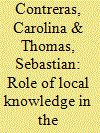| Srl | Item |
| 1 |
ID:
167535


|
|
|
|
|
| Summary/Abstract |
There has been a growing interest in restoring mangroves to reduce and offset carbon (C) emissions, but it is still unknown whether restored mangroves provide ‘blue carbon’ services similar to natural ones. This study aimed to determine if 10 year-old restored mangroves in abandoned aquaculture ponds in Perancak Estuary, Bali have similar net primary productivity (NPP) and C sequestration to those of intact mangroves. Tidal re-instatement in the ponds has occurred and facilitated mangrove regeneration and sediment accumulation. We found that NPP were similar between natural and restored mangroves. Soil C sequestration in restored mangroves was similar to the natural mangroves, but the soil respiration (CO2 efflux) was lower. The source of C in mangrove sediments was mainly of mangrove origin, confirming the role of NPP in sediment C sequestration. We suggest that many components of the carbon cycle of the mangroves have been restored within 10 years since the reestablishment of the mangrove.
|
|
|
|
|
|
|
|
|
|
|
|
|
|
|
|
| 2 |
ID:
167531


|
|
|
| 3 |
ID:
167537


|
|
|
|
|
| Summary/Abstract |
There are more than 1500 partnerships and initiatives currently addressing Sustainable Development Goal #14 (Life Below Water), with blue carbon activities – carbon-oriented conservation and restoration projects in coastal ecosystems – representing a small proportion. A key challenge for blue carbon initiatives is the integration of social and cultural dimensions within governance mechanisms – a common problem in global environmental governance. An important question is how these mechanisms integrate local knowledge, traditional customs, and rights, especially in the climate-vulnerable contexts of island states in the Indo-Pacific region. This study describes global blue carbon governance – considering market-based instruments, public investment, partnership initiatives, and community-centred management schemes – and evaluates the extent to which these different approaches facilitate or constrain the integration and agency of local knowledge. This research offers valuable insights on the applicability of blue carbon governance mechanisms in small island states (SIS) in the Indo-Pacific region, and their potential to contribute to sustainability outcomes including social-ecological health and environmental justice.
|
|
|
|
|
|
|
|
|
|
|
|
|
|
|
|
| 4 |
ID:
167533


|
|
|
|
|
| Summary/Abstract |
Fisheries are important sources of livelihoods to coastal communities. In the tropics fishing is conducted from mangroves, seagrass meadows to coral reefs. Studies on fisheries in the tropics have focused on coral reef fisheries, with little attention to seagrass meadows and mangroves. Using creel survey and in-depth interviews, this study assessed species composition, abundance and exploitation methods of fisheries from the seagrass meadows of Gazi Bay, Kenya. Eighty-five species were recorded with 8 species accounting for 75.7% of the total catch dominated by Leptoscarus vaigiensis, accounting for 30.9% of the total catch. Five dominant gears were observed: basket traps, hook and stick, handlines, nets and spear-guns. Basket traps were the most dominant accounting for 75.1% of the total catch by volume. These results underscore the value of the seagrass meadows to supporting fisheries. Gear management measures should be implemented for sustainability of the seagrass habitat and associated fisheries.
|
|
|
|
|
|
|
|
|
|
|
|
|
|
|
|